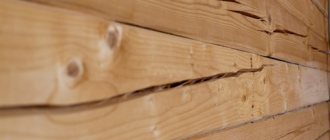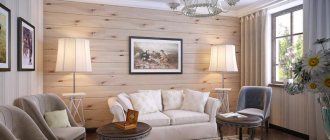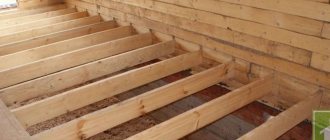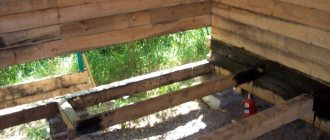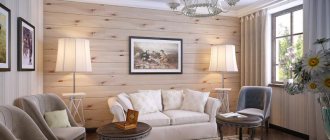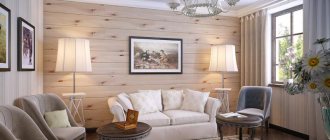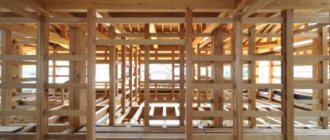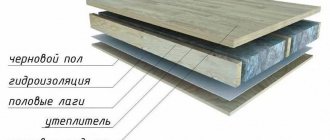An acceptable level of comfort that meets the requirements for living in a house, first of all, ensures an optimal microclimate of the interior, and only then the interior design and other components of the usual daily environment. If the climate is not comfortable, no chic and comfortable sofa is a joy. One of the key components of the atmosphere in interior spaces is air humidity - something that we cannot see, but we perceive very noticeably.
Unusually dry or humid air has a direct impact on a person’s well-being, leads to illness (such as bronchitis) and forces one to take measures to bring this parameter to the optimal value for a particular organism or encourages them to change their place of residence. That’s why various smart climate systems are in steady demand, but they still can’t do what solid wood naturally and freely can do. They can, of course, try, but so far this has only worked best with natural wood.
Solid coniferous wood, being a living material, can independently and at a level optimal for the human body maintain humidity suitable for all living things in the interior of a wooden house. It is possible that this is precisely what people who have a liking for such houses mean when they point out a significant advantage over artificial wall materials, citing the argument about the “breathing of wood.” It really is. True, how a tree determines whether to lower or increase air humidity in the house still remains a mystery. Obviously compares the ratio of temperature and humidity of the air inside the house and outside its walls.
When they say “wood breathes,” they may also mean convection and air recovery by wooden walls. Also significantly affecting the comfort of the microclimate in a wooden house. But operating with air humidity is more important, as it is felt more strongly. Natural wood takes excess moisture from the air in the interior, feeds it from the street, and takes moisture from the dew point in the log house log. And it moisturizes the air inside its walls as it dries. Moreover, coniferous species that are similar in physical and chemical characteristics, such as spruce and pine, do this differently.
The permeability and interaction with the vapor-gas mixture (in simple terms, air) are the same for these rocks. And the capacity of the same volume of wood is also identical, but pine, taking excess moisture from the air in the interior, gives back the full volume if necessary. And spruce also removes some of the moisture from the air to the street. Therefore, in a house made of pine, the humidity is usually higher, while spruce, because of this feature, is preferable to use for building a bathhouse. If your house is built from mixed pine-spruce wood, there is nothing to worry about; on the contrary, it will be optimal. By the way, in a building made of only spruce, due to the lower density of the wood, it is also warmer.
Regulating humidity with log walls is important at any time of the year. Especially in winter, when the air is driest due to low temperatures. In a log house, despite the dry air outside, the humidity does not drop below 40-50%. And in the summer, in hot and humid weather, the air in a house made of natural wood is dry enough to feel normal without air conditioning.
When regulating humidity, the tree works with all its volume. This means uniform distribution of the microclimate throughout the house. And the volume of a tree in a large house with a substantial diameter is considerable. This is reflected not only in the increased cost of wall material, but also in more serious possibilities for filtering indoor air. Since the limit of hygroscopicity (moisture saturation) is also increased, and even if it rains on the outside of the wall for a week, there will still be comfortable humidity inside. Moreover, on such a homogeneous (consisting only of itself) material, no dew falls on the surface of the log in the house. The movement of the vapor-gas mixture inside the walls occurs at the same speed and simultaneously in both directions. Wooden wall cladding and film-forming antiseptics only get in the way. Moreover, they can lead to damage to the tree.
Any capital building requires proper care and maintenance. Not only the level of comfort in the house and living conditions, but also the service life of the main structural elements of the building depend on this.
Residential buildings and other buildings made of laminated veneer lumber require more attention in this regard. Timber is a unique building material that has incomparably better technological characteristics compared to other building materials. If you comply with the necessary requirements for the care of residential buildings built from laminated veneer lumber and adhere to certain rules, you can significantly increase the durability of the structure.
Humidity control
A mandatory and main rule for the proper operation of residential buildings made of laminated veneer lumber is maintaining an optimal humidity regime.
Glued laminated timber, like any other industrial wood, depends on the level of humidity. Low humidity levels promote rapid drying of wooden structures. Wooden panels will lose their strength and integrity, and gaps and cracks will appear on the walls and between structural elements.
The ideal level of humidity in residential buildings made of laminated veneer lumber is observed in those buildings where people permanently live. Human activity and living conditions create an optimal level of indoor humidity.
In the absence of residents, the humidity level drops significantly, and wood quickly loses its basic technological characteristics. This is especially true for guest houses and residential properties designed for seasonal living. The more often the house is used for its intended purpose, the more durable the entire structure will be.
Normal temperature conditions and humidity inside the house are the main factors for increasing the service life of wooden buildings, but do not forget about ventilation. Glued laminated timber does not tolerate greenhouse conditions, when warm and humid air mass accumulates in the room. Constant ventilation and ventilation of the interior will significantly improve the performance characteristics of wooden panels, wall and ceiling structures.
All of the above rules, together with regular maintenance of a residential property, will invariably have a positive effect on the technical condition of the house.
Causes of dampness in a private home
We didn’t think about what exactly was the source of mold in our home. Because all possible factors suited our situation perfectly. Among the reasons that contribute to the appearance of dampness are the following:
- Roof. If there are cracks and the slightest unclosed gaps in the roof, any type of precipitation gradually penetrates into the home. At first, there are no signs of leakage on the ceiling, but over time, moisture accumulates, causing the development and spread of fungus.
- Foundation. The lack of low tide was the impetus for the beginning of the destruction of the foundation of the house. Plus, there were water pipes running under the floor that were leaking, and thus the foundation was washed out and dampness accumulated under the floor covering.
- Walls. They may be partially destroyed and covered with cracks. In our case, mold formed on them due to the lack of an exhaust hood in the bathroom and in the hallway.
- Wall covering. If the room is lined with plastic or other similar material, then it cannot “breathe”, which leads to the accumulation of moisture and the formation of mold.
- Underground. In the absence of supply and exhaust ventilation, dampness accumulates in a short time. In this case, the smell along with the fungus spreads throughout the entire home.
- Groundwater. When they are located close together, it is necessary to have high-quality waterproofing performed both inside and outside the house.
Attention! Dampness in a new wooden house can be caused by the use of undried wood during construction.
Maintenance
The technical condition of a residential building or any other structure made of laminated veneer lumber depends on a number of factors, not the least of which is maintenance. All wooden buildings are characterized by one property - shrinkage. During the first 3-6 months after completion of construction, all main structural elements shrink by 3-5%. That's why:
- Residential buildings should not be subjected to finishing work, both outside and inside;
- during the entire shrinkage period, equip residential properties with heating and ventilation systems;
- carry out redevelopment inside the house.
From a technical point of view, maintenance of a house made of laminated veneer lumber consists of carrying out the necessary measures. Inspecting the foundation, monitoring the condition of gutters, adjusting jacks and checking the position of studs. During the first two months, it will be necessary to monitor the shrinkage of the partitions and rafter system to determine the size of the existing gaps. Windows, doors and flights of stairs in the house need constant adjustment at first.
Traditional methods
“Grandma’s” method of humidifying the air using a wet cloth has already been forgotten and is irrelevant, but in a house with a Russian stove it was simply impossible to do without it. As the fabric dried, it evaporated moisture, saturating the oven-dried air. But the principle itself is universal, and today it is successfully used in compact battery humidifiers. A small ceramic or plastic water tank is attached to the heating radiator and gradually evaporates the moisture. This is the easiest and cheapest way to increase air humidity in winter. But it’s not the most convenient: it’s quite difficult to regulate the intensity of humidification, and you have to remember to add water.
Reducing humidity in summer using improvised means is much more difficult. Some obvious advice is not to hang wet laundry in the apartment (including balconies and loggias) and regularly ventilate the room. There is also a slightly exotic way to reduce humidity using calcium chloride, the crystals of which perfectly absorb moisture. But still the most effective method is conditioning.
Wood protection measures
The main challenge that will have to be faced when constructing residential buildings from laminated veneer lumber is to ensure reliable protection of the structural elements of the building. Wood is highly susceptible to atmospheric factors. Even taking into account the fact that the technology for manufacturing timber involves the use of special antiseptic solutions and impregnations, to improve the performance characteristics of the building, additional processing of the main structural elements will be required.
For these purposes, combined formulations are used that have an antifungal effect. Treating wooden structures with special solutions will increase the moisture resistance and fire resistance of the panels. It is better to carry out a similar procedure before painting the house. Most paints and varnishes today include special additives that have the necessary protective properties. It is advisable to start painting and treating the house in the warm season, when the air temperature does not drop below 5 0 C.
Particular attention during processing is given to the end parts of the timber. It is this part that is most susceptible to the negative effects of moisture and sunlight.
What is the most dangerous hack when installing a log house?
There are a huge number of ways to ruin a log house. However, there is nothing worse when “masters” use ordinary nails, screws or fittings instead of short wooden dowels when assembling a house. This approach inevitably leads to the appearance of cracks. It will no longer be possible to save a log house folded in this way - the entire structure is damaged.
A video from our channel will tell you how to unscrew the nut on an angle grinder disc if it is stuck:
If you want to learn even more useful things, then read about 4 proven methods for restoring support beams without major repairs.
Did you like the article? Then support us, click
:
Structural protection
Glued laminated timber, from which not only wall panels are assembled, but also other main structural elements of the house require attention. This is especially true at the initial stage, when shrinkage of a residential building occurs. First of all, the condition of the panel joints and the connections of house structures is checked. The vertical bars along which the sliding is carried out must ensure uniform lowering of the structures. It is necessary to monitor the condition of the casing of windows and doors.
The roofing elements are equipped with similar devices for uniform lowering, so this part of the house also requires attention. Such actions must be carried out regularly during the first 2-3 years after the facility is put into operation.
Synchronization of the entire process of lowering house structures is carried out using simple actions:
- tightening and shortening the coupling bolts;
- replacing deformed platbands, reinstalling skirting boards and correcting defects that occurred on flights of stairs;
- regular sanding of laminated timber structures.
What are the health implications of dampness in your home?
Dampness also negatively affects human health. Children and the elderly are particularly affected by mold and mildew.
Among the most common consequences of living in a damp room are the following:
- allergic reactions;
- development of dermatoses and mycoses;
- the occurrence of asthma attacks;
- ARVI;
- headache;
- constant malaise;
- dizziness;
- nausea;
- insomnia.
If the house smells damp, existing chronic diseases can suddenly worsen. Also, most common seasonal pathologies can, on the contrary, become chronic. Therefore, living in a humid microclimate entails not only negative aesthetic, but also physical problems.
Features of the operation of the house outside and inside
It was said earlier that caring for a house significantly extends its service life. However, it is worth dwelling in detail on the features of operating a house made of laminated veneer lumber, both outside and inside residential premises.
Painting the outside of the house and treating the main structural elements with special compounds are the very first steps for the subsequent proper operation of the residential property. High-quality painting provides reliable protection for house structures over the next 5-7 years. Subsequent sanding of the timber and another painting will add another 15-20 years of youth to your home.
When inspecting the outside of the house, carefully check the functioning of the drainage systems. When assessing the condition of the house, pay attention to the uniformity and integrity of the paint and varnish coating, and areas of exterior finishing with other materials. Regularly inspect the walls of the house for cracks and technological gaps. If possible, try to carefully repair facade defects with putty, restoring not only the attractive appearance of house structures, but also maintaining the integrity of the material.
A residential building made of laminated veneer lumber is a habitable space. The more often people stay there, the better the condition of the internal structures and the condition of the residential building itself. The internal microclimate is the key to successful and long-term operation of houses made of laminated veneer lumber.
For the normal condition of interior structures and surfaces, it is necessary to maintain constant humidity, at least 65%, and a balanced temperature regime. For walls, the optimal humidity is 5-6%. The temperature should neither drop nor rise sharply. For guest buildings and houses designed for temporary stays, rapid heating of the premises is unacceptable. Heating of the interior is carried out gradually. For two-story buildings, it is important to prevent the second floor from overheating. This can cause loss of stability and strength of the ceilings. This regime must be carefully observed in winter.
During the cold period, residential buildings should not be left without heating. Operating the heating system in maintenance mode allows you to maintain positive temperatures inside the premises.
Reviews
According to numerous reviews, the main reason for the appearance of moisture in old private housing is the lack of ventilation of the underground space and violation of the waterproofing of the foundation.
The main problem is related to poor quality construction work. Each stage of the construction of private housing must be carried out using technology. Otherwise, the appearance of humidity will lead not only to disruption of the healthy microclimate of the home, but also to the early destruction of the entire structure.
Compliance with fire safety measures
For any residential building, fire safety is a fundamental operating factor. Houses made of laminated veneer lumber, like most wooden buildings, should be provided with maximum fire protection. Compliance with fire safety rules for the inhabitants of the house and adequate behavior of residents are the key to comfort and safe living.
During construction, pay attention to the correct installation of furnace and boiler equipment. During the process of shrinking the house, monitor the condition of ventilation shafts and chimneys. As in any wooden house, in houses made of laminated veneer lumber you should not install open fires in unprepared places.
During the manufacturing process, glued laminated timber undergoes special treatment with special compounds. Fire retardants increase the fire resistance of the material, preventing it from quickly igniting. Therefore, during construction it is always important to evaluate the quality of the building material. The fake does not have high performance characteristics, so in the future additional work will be required to treat building structures with fire retardants.
Major League
All the achievements of modern climate technologies can be collected in one device - a climate complex. You can completely entrust him with taking care of the climate in the house, setting only the desired parameters, which will be maintained constantly. There are mobile climate control systems in the form of a separate unit, but most often these are built-in systems with a remote wall-mounted control panel. The most advanced models can be integrated into a smart home system, with remote climate control and changing parameters using a smartphone.
Regardless of the methods chosen, it is important to monitor temperature and humidity constantly, and not occasionally. In a house where the correct climate is maintained, residents have no problems either with health or with wooden floors.
conclusions
Like any housing, houses made of laminated veneer lumber must be operated in strict accordance with certain rules. By doing this, you guarantee your own safety and significantly increase the service life of residential buildings.
Compliance with the rules of use and operation, regular preventive measures is not a difficult task, but it requires systematization. Failure to comply with the rules and regulations often becomes the cause of premature destruction of laminated veneer lumber. The house quickly loses its attractiveness, and the technological characteristics of the wood decrease. In most cases, neglect of operating rules, especially at the initial stage, leads to a deterioration in the level of comfort in residential premises and affects the quality of life. To increase the durability of house structures, such measures can be carried out independently, but it would not be a bad idea to seek help in such situations from the services of specialists.
Recommendations from experts in the field of small house construction from laminated veneer lumber will help keep residential buildings functional and habitable.
To preserve wooden furniture and parquet Wooden flooring, furniture, musical instruments and other wooden accessories that are present in residential buildings, office buildings, and shops are sensitive to environmental influences. In other words, they are no less demanding of healthy climatic conditions than people. Why? The tree absorbs or loses moisture and, accordingly, expands or shrinks, depending on the level of humidity and ambient temperature. Everyone who has ever worked with it knows about this dependence of wood on humidity and temperature. Let us remember, if, of course, we carefully listened to the sellers of wooden furniture and parquet, that the fact that the parquet has dried out and the coating is all cracked will not be recognized as a warranty case if we did not comply with the requirements for caring for it.
What do you need to know about frame buildings?
Water vapor will always tend to leave the structure during the cold season if it has too low a vapor permeability coefficient. The worst thing is that steam will condense on the outside of the insulation, thereby causing the insulation to become wet. Wet insulation will completely lose all its positive qualities.
To prevent this from happening. a vapor barrier film should be installed directly under the inner lining of the frame. To achieve complete tightness, the joints are taped. A windproof film is also placed under the outer protection, which in turn allows water vapor to pass through properly.
